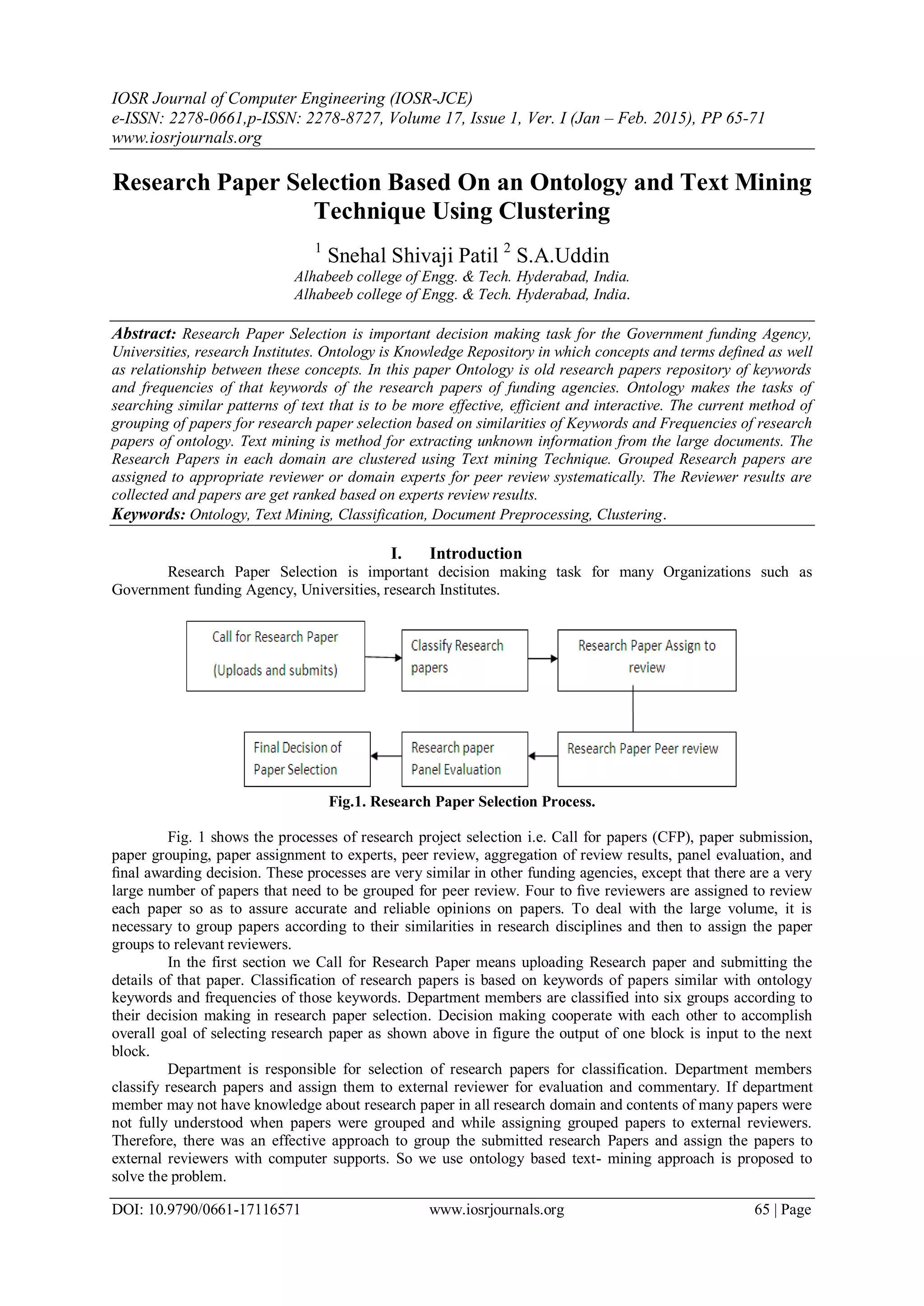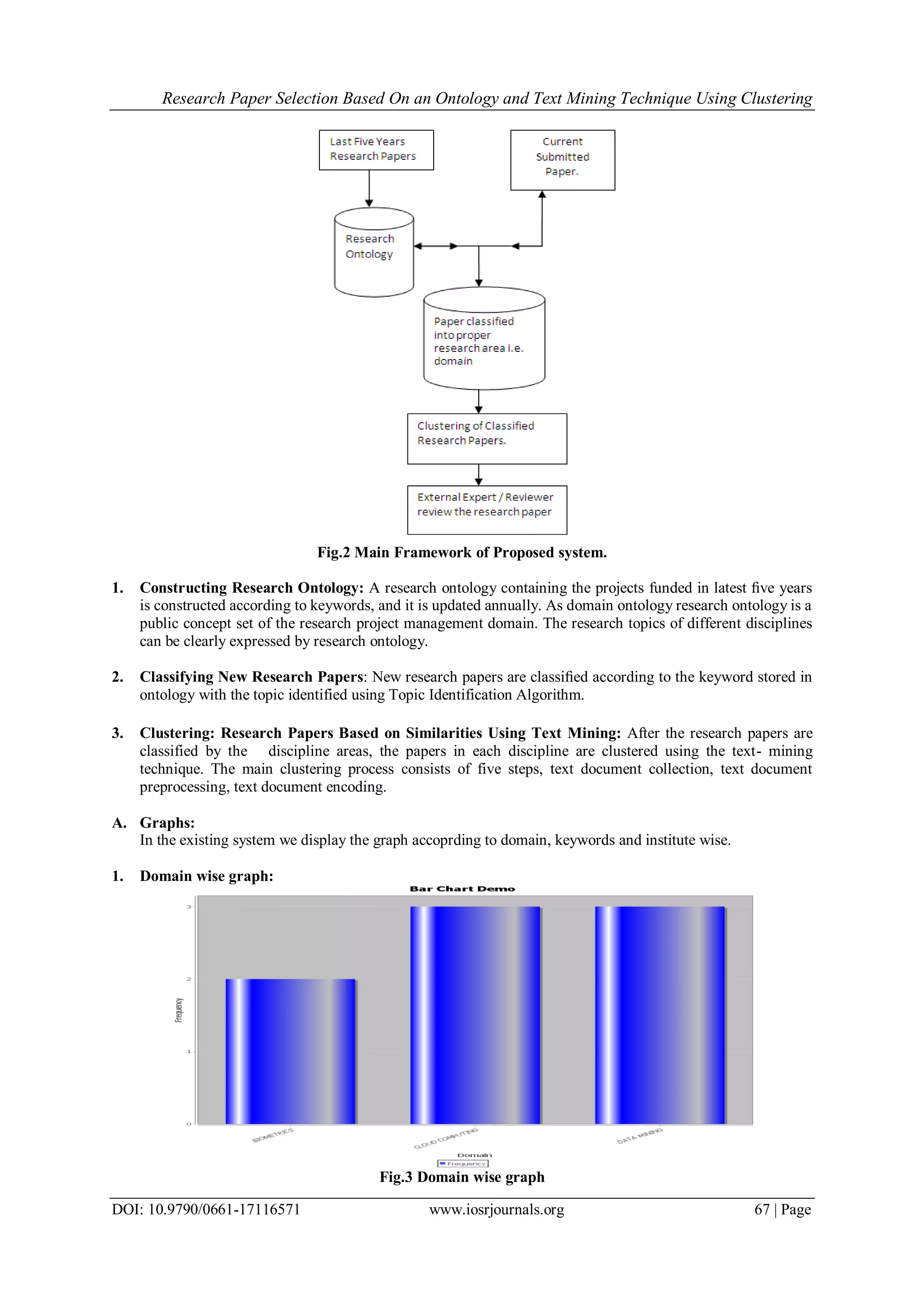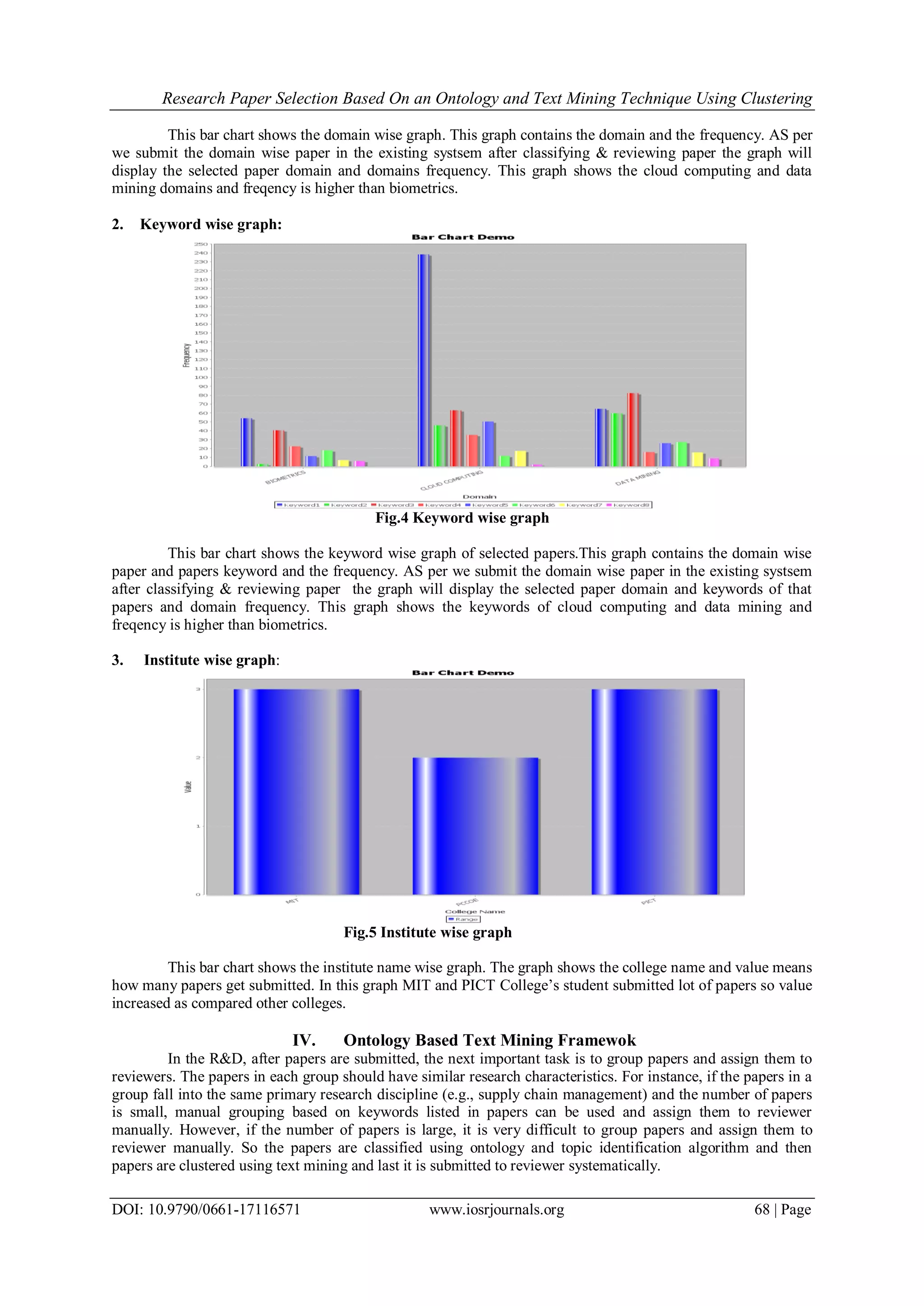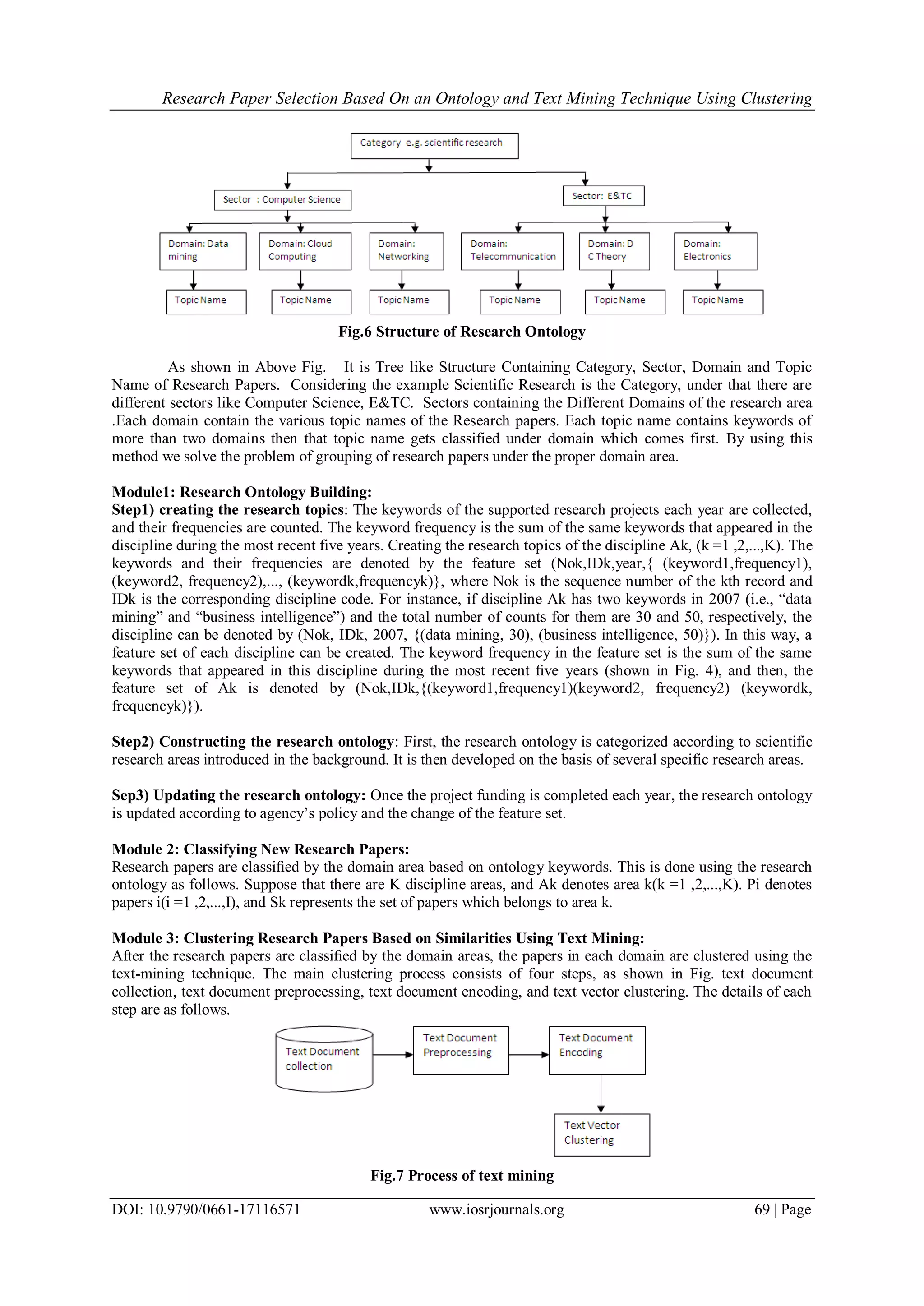This document proposes an ontology and text mining technique to select research papers. It involves 3 phases: 1) constructing a research ontology using keywords and frequencies from past papers, 2) classifying new papers based on ontology keywords, and 3) clustering papers in each domain using text mining and the K-means algorithm. The technique aims to better group papers and assign them to relevant reviewers by addressing limitations of keyword-based methods. It constructs a research ontology, classifies papers, clusters them based on textual similarities, and systematically assigns papers to reviewers.

![Research Paper Selection Based On an Ontology and Text Mining Technique Using Clustering DOI: 10.9790/0661-17116571 www.iosrjournals.org 66 | Page Section II reviews the literature on research paper selection, grouping of papers and assigning the grouped papers to external reviewer systematically. The proposed method on an ontology based text mining framework for Research Paper Selection is described in Section III. Section IV validates and evaluates the method, and then discusses the potential application. II. Literature Review Selection of research projects is an important research topic in research and development (R&D) project management. Previous re- search deals with specific topics, and several formal methods and models are available for this purpose. For example, Chen and Gorla [2] proposed a fuzzy-logic-based model as a decision tool for project selection. Henriksen and Traynor [3] presented a scoring tool for project evaluation and selection. Ghasemzadeh and Archer [4] offered a decision support approach to project portfolio selection. Machacha and Bhattacharya [5] proposed a fuzzy logic approach to project selection. Butler et al. [6] used a multiple attribute utility theory for project ranking and selection. Loch and Kavadias [7] established a dynamic programming model for project selection, while Meade and Presley [8] developed an analytic network process model. Greiner et al. [9] proposed a hybrid AHP and integer programming approach to support project selection, and Tian et al. [10] suggested an organizational decision support approach for selecting R&D projects. Cook et al. [11] presented a method of optimal allocation of papers to reviewers in order to facilitate the selection process. Arya and Mittendorf [12] proposed a rotation program method for project assignment. For example Choi and Park [13] used text-mining approach for R&D paper screening. Girotra et al. [14] offered an empirical study to value projects in a portfolio. Sun et al. [15] developed a decision support system to evaluate reviewers for research project selection. Finally, Sun et al. [16] proposed a hybrid knowledge-based and modeling approach to assign reviewers to papers for research project selection. Cheng and Wei [2008] proposed clustering-based category-hierarchy integration (CHI) technique, which is an extension of the clustering-based category integration (CCI) technique. This method was improving the effectiveness of category-hierarchy integration compared with that attained by nonhierarchical category- integration techniques particularly homogeneous [16]. Methods have been developed to group papers for peer review tasks. For example, Hettich and Pazzani [2006] proposed a text-mining approach to group papers, identify reviewers, and assign reviewers to papers. Current methods group papers according to keywords. Unfortunately, papers with similar research areas might be placed in wrong groups due to the following reasons: first, keywords are incomplete information about the full content of the papers. Second, keywords are provided by applicants who may have subjective views and misconceptions, and keywords are only a partial representation of the research papers. Third, manual grouping is usually conducted by division managers or program directors in funding agencies. They may have different understanding about the research disciplines and may not have adequate knowledge to assign papers into the right groups. [17] III. Existing System The existing system is an Ontology-Based Text-Mining Method to cluster research papers based on their similarities in research areas. It consists of three phases. Ontology is a knowledge repository in which concepts and terms are defined as well as relationships between these concepts. It consists of axioms, relationships and set of concepts that describe a domain of interests and represents an agreed-upon conceptualization of the domain’s ―real-world‖ setting. Implicit knowledge for humans is made explicit for computers by ontology. Thus, ontology can automate information processing and can facilitate text mining in a specific domain (such as research project selection). An ontology based text mining framework has been built for clustering the research papers according to their discipline areas. Text mining refers generally to the process of extracting interesting information and knowledge from unstructured text. The main difference between regular data mining and text mining is that text mining patterns are extracted from natural language text rather than from structured databases of facts.](https://image.slidesharecdn.com/m017116571-151119051223-lva1-app6892/75/Research-Paper-Selection-Based-On-an-Ontology-and-Text-Mining-Technique-Using-Clustering-2-2048.jpg)



![Research Paper Selection Based On an Ontology and Text Mining Technique Using Clustering DOI: 10.9790/0661-17116571 www.iosrjournals.org 70 | Page Step 1) Text document collection: After the research papers are classified according to the discipline areas, the paper documents in each discipline Ak(k =1 ,2,...,K) are collected for text document preprocessing. Step 2) Text document preprocessing: The contents of papers are usually nano structured. Because the texts of the papers consist of characters which are difficult to segment, the research ontology is used to analyze, extract, and identify the keywords in the full text of the papers.. Finally, a further reduction in the vocabulary size can be achieved through the removal of all stop words that appeared only a few times in all paper documents. Step 3) Text document encoding: After text documents are segmented, they are converted into a feature vector representation: V =( v1,v2,...,vM), where M is the number of features selected and vi(i =1 ,2,...,M) is the TF- IDF encoding [18] of the keyword wi. TF-IDF encoding describes a weighted method based on inverse document frequency (IDF) combined with the term frequency (TF) to produce the feature v, such that vi = tfi ∗log(N/dfi), where N is the total number of papers in the discipline, tfi is the term frequency of the feature word wi, anddf i is the number of papers containing the word wi. Thus, research papers can be represented by corresponding feature vectors. Step 4) Text vector clustering: This step uses K-MEANS clustering algorithm to cluster the feature vectors based on similarities of re- search areas. The K-MEANS clustering algorithm is a typical unsupervised learning neural network model that clusters input data with similarities. Details of the K-MEANS algorithm. V. Clustering Using K-Means Algorithm After the construction of the document vector, the process of clustering is carried out. The K-MEANS clustering algorithm is used to meet the purpose of this project. The basic algorithm of K-MEANS used for the project is as following: K-Means Algorithm Use: For partitioning where each cluster’s center is represented by the mean value of the objects in the cluster. Input: k: the number of clusters, Output: A set of k clusters. Method: Step 1: Choose k numbers of clusters to be determined. Step 2: Choose Ck centroids randomly as the initial centers of the clusters. Step 3: Repeat 3.1: Assign each object to their closest cluster center using Euclidean distance. 3.2: Compute new cluster center by calculating mean points. Step 4: Until 4.1: No change in cluster center OR 4.2: No object changes its clusters. VI. Conclusion And Future Work This paper has presented a framework on ontology based text mining for grouping research papers and assigning the grouped paper to reviewers systematically. Research ontology is constructed to categorize the concept terms in different discipline areas and to form relationships among them. It facilitates text-mining and optimization techniques to cluster research papers based on their similarities and then to assign them to reviewer according to their concerned research area. The papers are assigned to reviewer with the help of knowledge based agent. Future work is needed to replace the work of reviewer by system. Also, there is a need to empirically compare the results of manual classification to text-mining classification. Also there is need to sending message on user’s mobile number and also further profile schedule. References [1]. Y. H. Sun, J. Ma, Z. P. Fan, and J. Wang, ―A group decision support approach to evaluate experts for R&D project selection,‖ IEEE Trans Eng. Manag., vol. 55, no. 1, pp. 158–170, Feb.2008. [2]. A. D. Henriksen and A. J. Traynor, ―A practical R&D project-selection scoring tool,‖ IEEE Trans. Eng. Manag., vol. 46, no. 2, pp. 158–170,May 1999. [3]. S. Bechhofer et al., OWL Web Ontology Language Reference, W3C recommendation, vol.10, p. 2006-01, 2004.](https://image.slidesharecdn.com/m017116571-151119051223-lva1-app6892/75/Research-Paper-Selection-Based-On-an-Ontology-and-Text-Mining-Technique-Using-Clustering-6-2048.jpg)
![Research Paper Selection Based On an Ontology and Text Mining Technique Using Clustering DOI: 10.9790/0661-17116571 www.iosrjournals.org 71 | Page [4]. B. Yildiz and S.Miksch, ―ontoX—A method for ontology-driven information extraction,‖ in Proc.ICCSA (3), vol. 4707, Lecture Notes in Computer Science, O. Gervasi andM. L. Gavrilova, Eds., 2007, pp. 660–673, Berlin,Germany: Springer-Verlag. [5]. Jian Ma, Wei Xu, Yong-hong Sun, Efraim Turban, Shouyang Wang‖An Ontology-Based Text- Mining Method to Cluster Papers for Research Project Selection‖,IEEE Trans an systems and humans vol.42,no.3 May2012 [6]. A. Maedche and S. Staab, ―The Text-To-Onto ontology learning environment,‖in Proc. 8th Int.Conf. Conceptual Struct., Darmstadt, Germany,2000, pp. 14–18. [7]. E. Turban, D. Zhou, and J. Ma, ―A group decision support approach to evaluating journals,‖ Inf. Manage., vol. 42, no. 1, pp. 31–44, Dec. 2004. [8]. C. Choi and Y. Park, ―R&D paper screening system based on text mining approach,‖ Int. J.Technol. Intell. Plan., vol. 2, no. 1, pp. 61–72,2006. [9]. D. Roussinov and H. Chen, ―Document clustering for electronic meetings:An experimental comparison of two techniques,‖ Decis. Support Syst.,vol. 27, no. 1/2, pp. 67–79, Nov. 1999. [10]. C. Wei, C. S. Yang, H. W. Hsiao, and T. H. Cheng, ―Combining preference- and content based approaches for improving document clustering effectiveness,‖ Inf. process. Manage.,vol. 42, no. 2, pp. 350–372,Mar. 2006. [11]. T. A. Runkler and J. C. Bezdek, ―Web mining with relational clustering,‖Int. J. Approx. Reason., vol. 32, no. 2/3, pp. 217–236, Feb. 2003 [12]. H. Li, K. Zhang, and T. Jiang, ―Minimum entropy clustering and applications to gene expression analysis,‖ in Proc. 3rd IEEE Comput. Syst. Bioinform. Conf., Stanford, CA, 2004, pp. 142–151. [13]. S. Gauch, J. Chaffee, and A. Pretschner, ―Ontology-based personalized search and browsing,‖ Web Intell. Agent Syst., vol. 1, no. 3/4,pp. 219– 234, Dec. 2003. [14]. L. M. Meade and A. Presley, ―R&D project selection using the analytic network process,‖IEEE Trans. Eng. Manag., vol. 49, no. 1, pp. 59– 66, Feb. 2002. [15]. Hossein Shahsavand Baghdadi and Bali Ranaivo-Malançon ,―An Automatic Topic Identification Algorithm,‖ Journal of Computer Science 7 (9): 1363-1367, 2011 ISSN 1549-3636 [16]. T. H. Cheng and C. P. Wei, ―A clustering-based approach for integrating document-category hierarchies,‖ IEEE Trans. Syst., Man, Cybern.A,Syst., Humans, vol. 38, no. 2, pp. 410–424, Mar. 2008. [17]. S. Hettich and M. Pazzani, ―Mining for paper reviewers: Lessons learned at the National Science Foundation,‖ in Proc. 12th Int. Conf.Knowl. Discov. Data Mining, 2006, pp. 862–871.](https://image.slidesharecdn.com/m017116571-151119051223-lva1-app6892/75/Research-Paper-Selection-Based-On-an-Ontology-and-Text-Mining-Technique-Using-Clustering-7-2048.jpg)